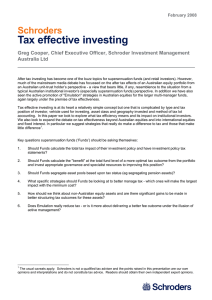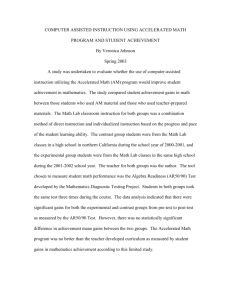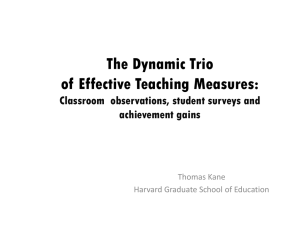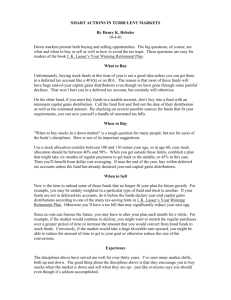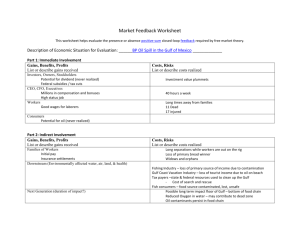- Schroders
advertisement
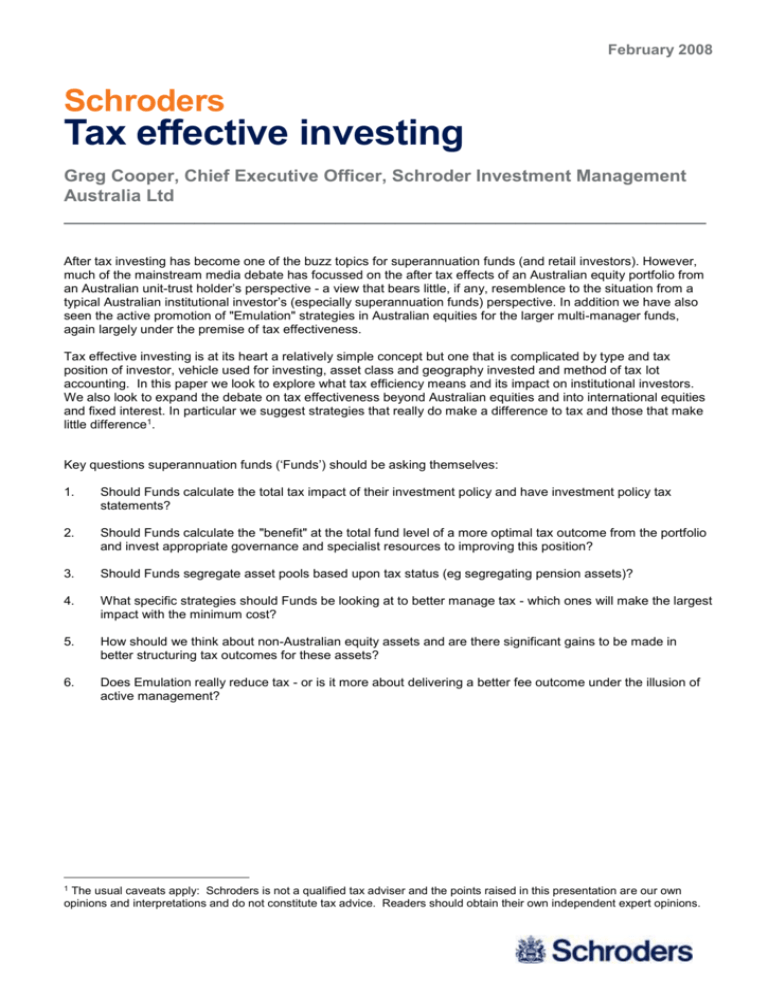
February 2008 Schroders Tax effective investing Greg Cooper, Chief Executive Officer, Schroder Investment Management Australia Ltd ________________________________________________________________ After tax investing has become one of the buzz topics for superannuation funds (and retail investors). However, much of the mainstream media debate has focussed on the after tax effects of an Australian equity portfolio from an Australian unit-trust holder’s perspective - a view that bears little, if any, resemblence to the situation from a typical Australian institutional investor’s (especially superannuation funds) perspective. In addition we have also seen the active promotion of "Emulation" strategies in Australian equities for the larger multi-manager funds, again largely under the premise of tax effectiveness. Tax effective investing is at its heart a relatively simple concept but one that is complicated by type and tax position of investor, vehicle used for investing, asset class and geography invested and method of tax lot accounting. In this paper we look to explore what tax efficiency means and its impact on institutional investors. We also look to expand the debate on tax effectiveness beyond Australian equities and into international equities and fixed interest. In particular we suggest strategies that really do make a difference to tax and those that make little difference1. Key questions superannuation funds (‘Funds’) should be asking themselves: 1. Should Funds calculate the total tax impact of their investment policy and have investment policy tax statements? 2. Should Funds calculate the "benefit" at the total fund level of a more optimal tax outcome from the portfolio and invest appropriate governance and specialist resources to improving this position? 3. Should Funds segregate asset pools based upon tax status (eg segregating pension assets)? 4. What specific strategies should Funds be looking at to better manage tax - which ones will make the largest impact with the minimum cost? 5. How should we think about non-Australian equity assets and are there significant gains to be made in better structuring tax outcomes for these assets? 6. Does Emulation really reduce tax - or is it more about delivering a better fee outcome under the illusion of active management? 1 The usual caveats apply: Schroders is not a qualified tax adviser and the points raised in this presentation are our own opinions and interpretations and do not constitute tax advice. Readers should obtain their own independent expert opinions. February 2008 Introduction For a typical Australian domiciled investor, taxation of investment returns is an unfortunate side effect of the process of generating positive (and in some cases negative) investment returns. While institutional investors are reasonably cognisant of the need to generate post-inflation returns over time, it is somewhat more difficult to estimate and convey the degree to which post-tax returns impact investors. This is largely because: – – Much of the return comparison in our industry is conducted on a pre-tax basis; In many cases the post-tax return to the investor is subject to the investor’s individual circumstances as well as the specific circumstances of the investment itself – all of which will vary for different individuals/entities. The process of generating a net of tax return can be broadly summarised diagrammatically below. Franking Credits Earned Only part of this may be visible to the manager or fund CGT Income Tax Withholding Tax Foreign Tax Credits Pre-Tax Return Fund Managers are largely assessed on this Net Return Usually regarded as an outcome of the process Investors actually care about this Source: Schroders The key principles to tax effective investing revolve around the following: 1. Defer paying tax as long as possible 2. Take advantage of concessional rates of tax where they are available (eg. capital gains discount available on assets held for more than 12 months or tax free status of retirement assets, superannuation tax rates vs individual tax rates) 3. Make full use of tax credits (eg. Franking or foreign tax credits) 4. Don’t give up obvious tax incentives (eg 45 day rule on franking) 5. Take advantage of specialist tax incentives (eg buybacks for some investors) when available 2 February 2008 A simple problem, made complex While in theory the process of generating a net of tax return is reasonably straightforward, the reality is far more complicated and can depend significantly on: – The tax status of investor, in particular whether they are: – – – – – A superannuation fund (lower tax rates – and nil for pensions, subject to FIF exemption) Corporations Individuals (at their respective differing tax rates) Non taxable entities (entitled to franking credits) Non taxable entities (not entitled to franking credits) – The choice of investment vehicle and domicile (direct holdings of securities vs indirect holdings of securities, Australia vs offshore) – The asset class (equities, fixed interest, hybrids) – Geography of the investment and relevance of any tax treaties (Australian vs offshore – tax treaty / non-tax treaty) – Method of tax lot accounting used and the specific method of parcel selection (aggregated or at individual portfolio level, methodology for selection – FIFO, Least Capital Gain) In discussing the subject of tax effective investing we must also be careful to separate out the degree to which tax efficiency can be obtained through tax efficient strategies versus tax efficient structures. Tax efficient strategies represent an investment process around security and asset class selection and management which is designed specifically to minimise the tax impact on the underlying investors. This can include: - Deferring tax through low turnover strategies and/or parcel selection Ensuring the maximum use of tax credits (eg. Franking) Holding assets for more than 12 months to maximise CGT discount Considering different offshore jurisdictions from the perspective of the security’s actual return to minimise withholding tax and claiming any foreign tax paid Considering the after-tax implications of security selection at individual security level (e.g. franking and tax impact opportunity costs, type of cashflow) Tax efficient structures represent the selection of the most appropriate vehicle through which to hold the underlying securities to obtain the most tax efficient outcome. This can include: - The use of direct holdings rather than Australian domiciled unit trusts; ETF’s; Accumulating offshore funds for Superannuation vehicles or other entities not subject to FIF rules; Separation of assets into pension, non-pension super and non-super vehicles to ensure the full tax benefits of each structure are obtainable. The relative benefits of various tax strategies In determining the relative merits of various tax strategies, it is important to understand which elements of the tax structure impose the greatest burden on investors. We can broadly consider these as: - 2 3 Income2 vs discount capital gains (given that most tax paying investors are subject to a lower rate of tax on assets held for more than 12 months) We include capital gains realised on the sale of assets held for less than 12 months in ‘income’ February 2008 - The “deferral” benefit – the degree to which not selling assets and creating a payable tax liability generates a “roll-up” effect as tax is deferred (note: tax is only deferred, a liability for tax still exists and should be accounted for) Franking credits – the franking benefit obtained on assets entitled to franking credits which have been held for more than 45 days. - Given the short holding period required to obtain franking credits, it would appear to us to be inappropriate to consider an investment strategy that didn’t retain the benefit of any franking credits – and as such we do not consider this further beyond that statement. However this may be an issue for very short term trading orientated strategies. There has been considerable debate around the relative benefits of “deferral” of tax payments. This is particularly the case within the media in the comparison of Index Funds vs Active Funds (more on this later). With the exception of the potential roll-over benefit at retirement where accrued capital gains can be moved into a pension fund and then sold with no tax payable, the real benefits of a deferral strategy are simply that – the prospect that the payment of tax can be deferred for a period of time – it does not mean that the tax is not payable. In the table below we show the relative annualised benefits to a superannuation fund (15% tax rate payer) and a top marginal tax rate payer (Individual, 45% tax payer) of a buy & hold strategy versus strategies which do not defer tax or are unable to take advantage of the CGT discount on assets held for more than 12 months. Superannuation Fund Year 1 Year 2 Year 3 Year 4 Year 5 Year 6 Year 7 Year 8 Year 9 Year 10 Value of deferral 0.00% 0.02% 0.04% 0.06% 0.08% 0.10% 0.12% 0.13% 0.15% 0.16% Value of discount 0.28% 0.30% 0.32% 0.34% 0.36% 0.38% 0.39% 0.41% 0.43% 0.44% Individual Value of deferral 0.00% 0.04% 0.08% 0.12% 0.15% 0.19% 0.22% 0.25% 0.29% 0.32% Value of discount 1.28% 1.32% 1.36% 1.40% 1.44% 1.47% 1.50% 1.54% 1.57% 1.60% Source: Schroders. The figures represent the % benefit of deferral or discount calculated by comparing the difference between a perfect deferral strategy (one where all non-income gains are discount gains and deferred till the year of redemption) and strategies which are unable to defer or take advantage of the CG discount. Assumed annual rate of income gain is 4% and annual rate of other gains is 6% It is quite clear from the table that the most significant benefit for both superannuation funds and individuals is the sharp reduction in the actual tax rate from obtaining gains as discount capital gains rather than as income. The value of a deferral clearly grows over time, but remains somewhat modest relative to the value of the CGT discount especially for super funds. From the perspective of considering an “active” strategy (implying turnover of the underlying securities) vs a passive strategy (implying no turnover) the figures in the table can provide an indication of the approximate “alpha” that the active strategy needs to obtain to offset the tax inefficiency of an active strategy. For example, an active manager with high turnover who never holds assets more than 12 months would have to generate 0.50% p.a. (0.16% to overcome deferral and 0.44% to overcome discount disadvantage) while an active manager with low turnover and capital gains all subject to discount would only need to generate an additional 0.16% p.a. in return over a 10 year period to deliver an equivalent after tax return for investors to a perfect passive fund. While the required alpha will vary depending on actual return and time horizon the key points are that the most important driver of post tax returns is the extent to which underlying securities are retained for 12 months and benefit from discount capital gains. This significantly outweighs the benefit of deferral for deferral’s sake. 4 February 2008 In general, we would make the observation that: – – – Alpha generating opportunities must be balanced against the size of the tax effects Opportunities will differ by type of investor and tax rate Some strategies (eg not selling stocks held for less than 12 months) have a far bigger ‘bang for your buck’ than strategies designed purely around deferral The importance of “structures” On the basis that it is the process of converting income into capital gains (or not converting gains into income) that holds the greatest potential from a tax management perspective, we should also consider the relative merits of different tax structures that are available as a way to reduce tax. In particular, for superannuation funds the FIF exemption provides a considerable potential benefit to funds for the accumulation of offshore earnings as capital gains rather than income. The table below highlights the tax effects of holding assets through a domestic (Australian) investment vehicle. Offshore Assets Onshore Assets Foreign Credits Withholding Tax Franking CGT upon redemption Investor Pass through of income and tax credits Onshore Funds Tax event creation Other Investors Source: Schroders In particular we would note in this structure that: – – – The cashflow actions of other investors will create tax events in the Australian trust that are beyond the control of the manager or the original investor (eg. A redemption by an investor will require the manager to liquidate assets which may realise gains which get distributed to other investors); The onshore fund will generate income gains through interest, dividends and turnover of securities held for less than 12 months; Franking credits and foreign tax credits can be passed through to the end investor. However, if we contrast this with the situation where assets are held through an offshore trust (especially foreign assets) we find as noted in the diagram below that: 5 Cashflow actions of other investors do NOT create tax events in the trust; For offshore funds which roll up income in the unit price (‘accumulation funds’) there are no disbursements of income so all investment returns have the potential to be treated as discount capital gains; February 2008 - This is offset against the lack of franking credits (for Australian assets), payments of withholding taxes where applicable and the lack of foreign tax credits. Offshore Assets Onshore Assets Withholding tax CGT upon redemption Investor Net Withholding Tax Offshore Funds No impact Other Investors Source: Schroders Note that not all foreign jurisdications permit the roll up of income in the unit price. US and UK domiciled funds, like their Australian counterparts, are required to distribute income to investors each year. One should also consider whether or not the foreign jurisdiction will impose withholding or other taxes on distributions from the pooling vehicle paid to the investor. Luxembourg, a poplular offshore fund jurisdication, does permit the roll up of income in the unit price and generally does not impose taxes on income or profits paid to investors from funds 3. However, it does suffer from not having Double Tax Agreements with as many countries so what is gained from tax deferral is offset somewhat by a higher withholding tax impost. For example, the following table shows a selection of WHT rates for Lux and Australian domicile funds. One of the key differences being that Lux funds have no double taxation agreement with the United States so tax is withheld at the full 30% from US dividends. Country Dividends Lux domicle fund Corporate Govt bonds bonds Capital gains Dividends Australian domicile fund Govt Corporate bonds bonds Capital gains United States 1 30 30/0 30/0 0 15 0 0 0 UK FRANCE GERMANY 2 3 4 0 25 15 20 0 0 0 0 0 0 0 0 0 15 15 0 0 0 0 0 0 0 0 0 Australia Japan 5 6 0/30 7 10/0 15 10/0 0 0 0 0 7 0 10 0 0 0 0 NOTES 1 2 3 4 5 6 3 6 Broad exemptions apply reducing WHT from 30% to nil in many circumstances for US bonds. W-8 forms need to completed WHT on govt bonds only exempt upon application to Japanese Ministry of Finance Lux funds qualify for double tax treaty with Germany. Nil WHT on franked dividends, otherwise 30%. If bonds meet public offer test then WHT can be reduced to nil. The 7% rate will rise to 15% from 1 April 2008 Luxembourg does impose an annual assets based tax (either 5bp or 1bp) on all FUM. February 2008 The WHT regimes are complex and constantly changing and administratively burdensome to reclaim so investors should consult with their custodians and tax experts for the latest withholding tax rates applicable to their funds. Other activities such as securities lending may also assist in offsetting part of this WHT burden. All told, we would expect that for a Superannuation Fund, a significant improvement in the after tax position may be possible through the use of a properly structured foreign unit trust (eg. A Luxembourg based fund) as a holding vehicle for offshore assets relative to a local unit trust or direct holdings of securities. In this situation, “turnover” of the strategy is actually irrelevant as there is the potential for all gains (including income gains) to be rolled up in the unit price and ultimately classed as discount capital gains. This would be especially important in respect of fixed income holdings where, all other things being equal, the benefit of an offshore structure could be in the order of 20-30bp pa. In reality withholding tax issues would require special consideration in order to not limit the potential benefit especially for Australian fixed interest assets held in a foreign fund. Another interesting outcome is that the use of an offshore structure could not only defer tax by rolling up income into the unit price but might actually result in no tax being paid if the assets transition to supporting a retirement income stream. Tax myths As we have outlined above, the benefits to investors on an after tax basis are significantly impacted by the extent to which gains are classified as “discount” vs “income”. However, much of the reporting in the press and indeed even the more commonly used “after-tax” measures from research houses such as Morningstar’s “tax cost ratio” ignore either the tax liability from the accrued gains not paid or the split in unit trust distributions between discount and non-discount gains. Representations such as those above which purport to show the effect of tax on returns by splitting distributions into “income” and “growth” are actually representations of the “distributed return” and the “non-distributed” return. They do not show the split in the distributed return between discount and non-discount gains which is the most critical piece of information in determining the relative tax efficiency of strategies. 7 February 2008 Emulation strategies Another increasingly common strategy being utilised by multi-manager funds is that of “Emulation” of Australian equity portfolios. Emulation essentially involves the “aggregation” of part of the portfolios of a number of underlying managers and then the construction of an “optimal” portfolio to reflect the aggregated portfolio and trade ideas from the underlying managers. One of the more commonly cited reasons for implementing this strategy is that of the potential tax and transaction cost savings from “crossing” of trade ideas within the portfolio. Just how large these benefits might be would depend upon the stock ideas which are crossed, how long one is prepared to wait between when one manager submits an idea and when the next manager submits an idea, etc. All in all it is likely that the benefits of emulation especially when combining low turnover managers will be quite small. These benefits could clearly be obtained by a properly structured aggregated custodial function rather than the employment of an Emulating Manager and the cost of such a service should not be more than a few basis points at most Emulation may only be of plausible benefit where the asset class involved is relatively narrow and the managers involved are high turnover and even in that case the tax benefits are dubious relative to other possible alternatives. As such emulation may only ever make sense for Australian equity assets and not for global assets where an offshore domiciled vehicle makes the need for emulation redundant. Conclusions It is important to understand the relative magnitude of various tax strategies and that this is going to be critically different for different types of investors (noting that Funds with mixed investor types have already potentially given up a substantial tax benefit that could be obtained as they have reduced their flexibility). As has been shown above, the greatest tax benefits can be obtained through a focus on ensuring as much of the gains in a fund are “discount” gains as opposed to income gains. This could be achieved through a number of different strategies: – – – Low turnover strategies Structuring offshore investments for superannuation funds through offshore fund vehicles Aggregated parcel selection Given the magnitude of potential tax savings (>10bp pa) it would appear that if measured from an after tax basis, the devotion of additional resources to tax minimisation by Funds represents an opportunity for gain. Key issues that Funds themselves should be concerned with: – Is the investment strategy itself built from a post-tax optimal perspective? – Is the most efficient method of implementing the particular strategy being utilised (onshore fund, offshore fund, direct holding)? – Is the alpha opportunity (if any) of sufficient potential to overcome the tax impact – both at the individual manager level and at the fund aggregated level? – Is the tax strategy of sufficient significance to justify the operational, time and cost implications to attain the tax efficiency (at fund and manager level)? – Is the total tax bill (both explicit and implied) being monitored to ensure maximum tax efficiency to the end investor and where “gains” can be made (e.g. aggregated tax lot accounting, parcel selection)? 8 February 2008 Appendix 1 – Tax efficiency in pooled funds Managed funds are the predominant vehicle used to pool individual investor assets in Australia. However this raises additional complexity due to the rules which require realised gains/income to be distributed to investors each 30 June. Some examples of the issues which can arise in a fund are as follows: – – – – The most tax efficient funds, eg a buy & hold index fund, could still have extreme levels of distributions if the fund is shrinking in size Investors can convert capital to income if they invest just before a distribution Redeeming investors crystallise capital gains which get distributed to other unitholders Tax losses may get trapped in the fund However, as discussed previously in this paper these issues relate largely to the timing of when an investor pays tax. For example, investing just before a distribution will result in capital being converted to income on which an investor must pay tax but this should result in the investor paying less capital gains tax when they finally redeem their investment. The end result is that the impact on the after tax return for the investor is not as large as might be expected. Superannuation funds have the advantage of being able to invest in offshore funds which enables all income and gains to be rolled up in the unit price thus deferring tax until redemption and qualifying for a concessional rate of tax as a result of the capital gains discount. There are various measures used to compare the tax efficiency of pooled funds. These include: – – – ‘Tax Cost Ratios’ Income/Growth return splits ‘After tax value of investment’ comparisons However, these measures can be grossly misleading: – – – Only provides a rear view mirror perspective – past performance provides no indication of likely tax efficiency going forward Young funds or those funds with strong inflows will have (all other things being equal) better tax efficiency than older funds or funds in outflow regardless of how tax efficient your strategy is. Sometimes measures provide an incomplete picture of the after tax returns to investors by ignoring the eventual deferred capital gains tax liability which may fall due when an investor finally redeems their investment A common approach to looking at the tax efficiency of funds is to look at the split of the total return into income and growth components. However, as we saw earlier, the proportion of discount gains in the income component makes a huge difference to the tax efficiency of a fund so a simple income/growth split of a fund distribution provides an incomplete picture of the tax efficiency of a fund. The after tax return varies enormously depending upon the % of discount gains in the income distribution. In fact this is the most important issue when assessing the tax efficiency of funds. 9 February 2008 Disclaimer Opinions, estimates and projections in this report constitute the current judgement of the author as of the date of this article. They do not necessarily reflect the opinions of Schroder Investment Management Australia Limited, ABN 22 000 443 274, AFS Licence 226473 ("Schroders") or any member of the Schroders Group and are subject to change without notice. In preparing this document, we have relied upon and assumed, without independent verification, the accuracy and completeness of all information available from public sources or which was otherwise reviewed by us. Schroders does not give any warranty as to the accuracy, reliability or completeness of information which is contained in this article. Except insofar as liability under any statute cannot be excluded, Schroders and its directors, employees, consultants or any company in the Schroders Group do not accept any liability (whether arising in contract, in tort or negligence or otherwise) for any error or omission in this article or for any resulting loss or damage (whether direct, indirect, consequential or otherwise) suffered by the recipient of this article or any other person. This document does not contain, and should not be relied on as containing any investment, accounting, legal or tax advice. Past performance is not a reliable indicator of future performance. Unless otherwise stated the source for all graphs and tables contained in this document is Schroders. For security purposes telephone calls may be taped. 10
